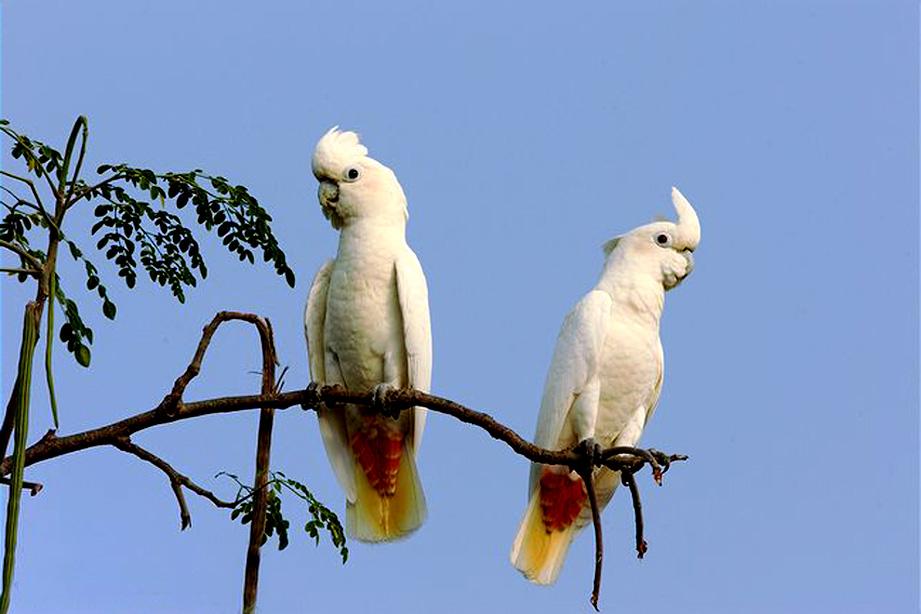

First you need to get to Manila, then get a short domestic flight to Puerto Princesa. Getting here is quite an adventure in itself. Recent estimates by Widmann (2001) suggest 1000 individuals left in the wild! Rasa probably holds the highest population density with 200 recorded individuals. Can be seen singly or in flocks of up to 30 or more. Their habitat is lowland, riverine, and mangrove forests but may be found in forest edge and open fields as well as high in the mountains. The Katala as it is locally called is a social species which roosts, feeds, and flies in noisy groups. It is 12.2 inches long and has an 8.6 inches wingspan. The white plumage is extremely conspicuous in flight and in the foliage of the lowland dipterocarp and mangrove forest habitats. The endemic Philippine or Red-vented cockatoo is a small psittacine with a helmet crest and red undertail coverts. This is the stronghold of the few remaining Red-vented Philippine Cockatoo (Cacatua haematuropygia). Though many tourists make the trek up north, very few head south to see the rare feathered gems on the private Rasa Island near the small town of Narra.

The lush tropical island of Palawan, Philippines is well known as a location for spectacular diving in the northern resort of El Nido. You can organize a similar trip with the Katala Foundation. This is a historical report of a trip we did in Sept 2010, before I started blogging so the details aren’t as good as my more recent trips. Posted in Conservation, Destinations | Tagged Katala Foundation, Palawan, Philippine Cockatoo, philippines | 1 Reply A Visit To Rasa Island, Palawan Since we were larger than the locals, we paid for 3 seats to be more comfortable, it was still really cheap. Back then, I think I had a Canon450D with 55-250mm lens.Īfter our visit, we caught a minibus back to Puerto Princesa. My very shaky video of our trip, it does get better towards the end with some close-ups. Annual festivals feature people dressing in Katala costumes! For more information on the Katala Foundation, booking an eco-tour or learning more about these rare cockatoos, please visit their website. They organize schools, festivals, field trips and build community pride in the Katala. One of the most important aspect of any bird conservation program is to get the local people involved and the Katala Foundation is one of several conservation programs sponsored by Loro Parque Fundacion. Malunga seed pods left over from the cockatoos. Ivy showed me the seed pods they eat and some of the log books. We enjoyed watching them for about an hour, then they flew off. Thanks to the Katala Foundation, the locals now treasure their endemic bird and even assist in monitoring the preferred feeding trees and keep logs of Katala visits. Therefore the cockatoo was formerly regarded as a pest. The species is very adaptable and even forages on crops, particularly rice in a half-ripe stage and corn.

The Philippine cockatoo feeds on seeds, and, to an extent, on fruits, flowers, buds and nectar. Ivy said that the people don’t mind if tourists with the Katala Foundation enter their backyards to see the birds. There were around 5 or 6 flying between trees in people’s backyards. This is the Katala Foundation’s monitoring project where the locals keep track of the cockatoos. This was where I got to see the Katala much closer and get better photos. We landed ashore and got the tuk-tuk to a small road in the middle of the village surrounded by family homes. As we drove back, I could see several pairs heading to Narra. They didn’t linger, hungry cockatoos want to eat so they flew off to foraging grounds on the island and mainland. I sat in the gently rocking boat trying to get photos and video as they flew around the roosting site. We followed in the boat.īack on the mainland we took a tuktuk to the feeding site. They flew back to the mainland in small flocks. They were pretty lazy and took their time but gradually more and more Katala would wake up, fly between the trees looking for their friends and of course making noise! There were signs of stirring about half an hour later as dawn broke and the sky grew lighter. We arrived around 5:30am, set anchor and waited for the cockatoos to wake up. Although it is possible to land at certain times of the year, they prefer not to as it disturbs nesting and breeding Katala. Benito was waiting right on time and we were able to get a bit closer to the roosting site. Ina opted to sleep a bit more so it was just Ivy and me this time. Wake up call was bright and early-4:30am so we would reach the island by dawn. After a brief sunset visit to see the Philippine Cockatoos roost for the night, now we would have the chance to see them wake up and fly to the mainland.


 0 kommentar(er)
0 kommentar(er)
